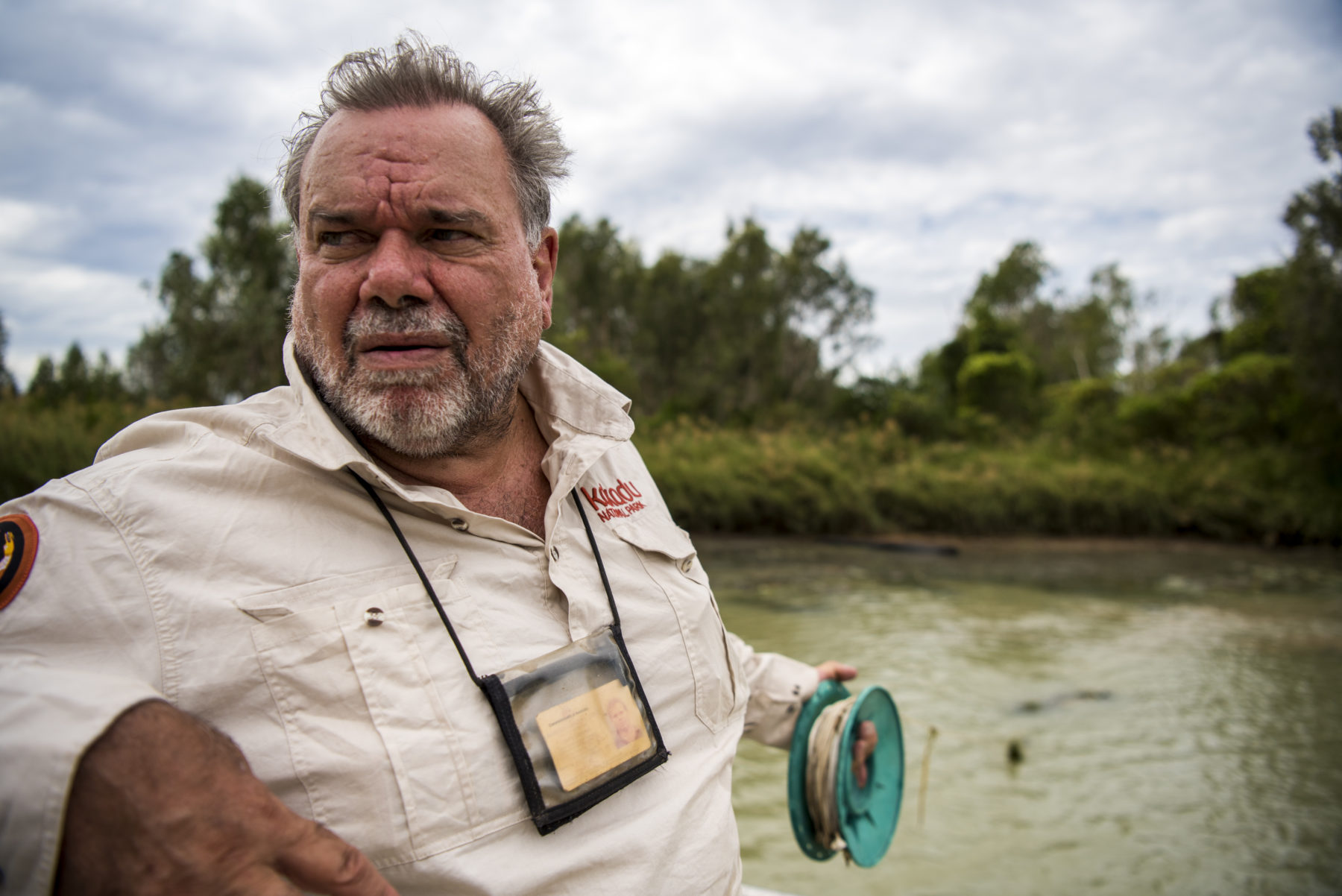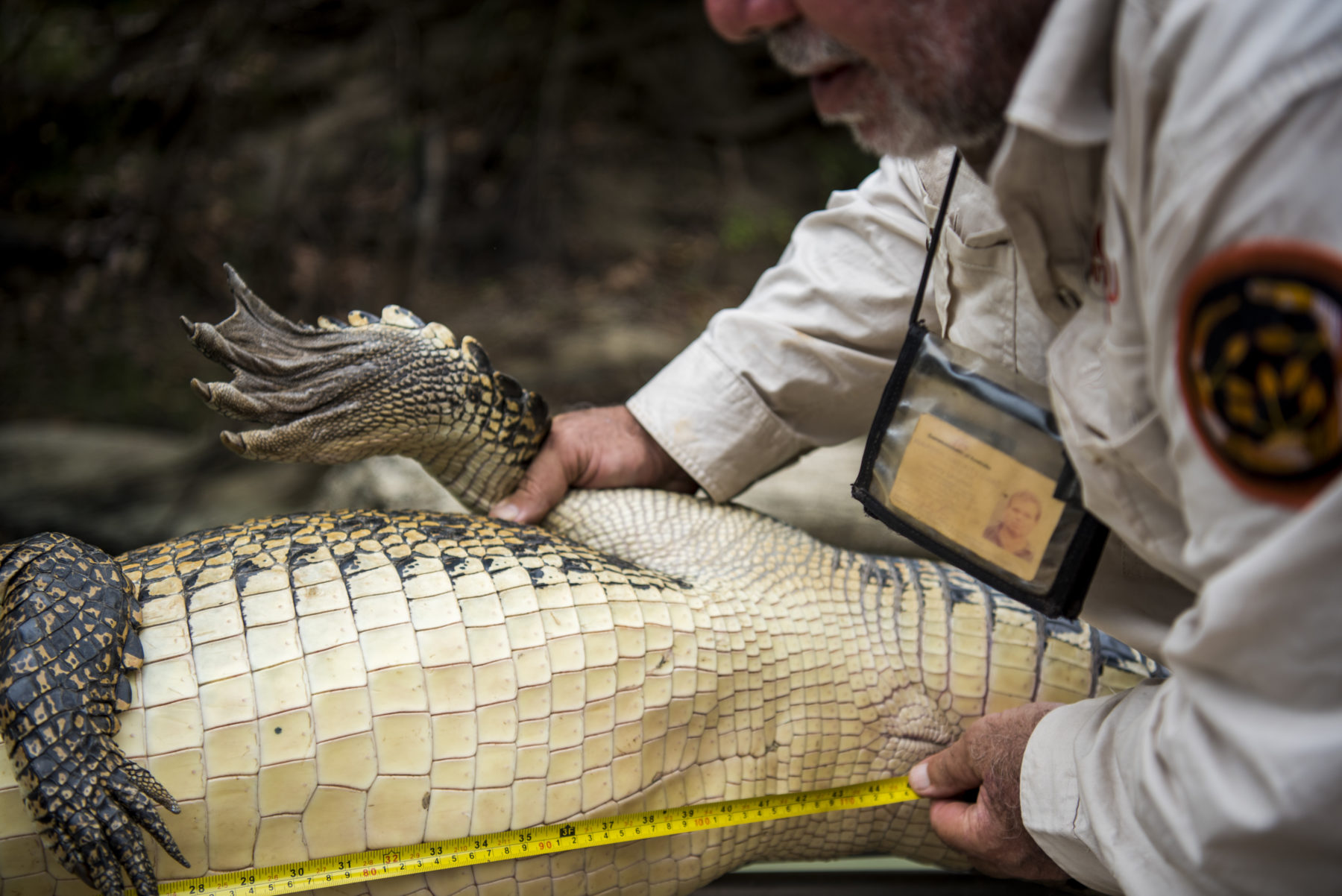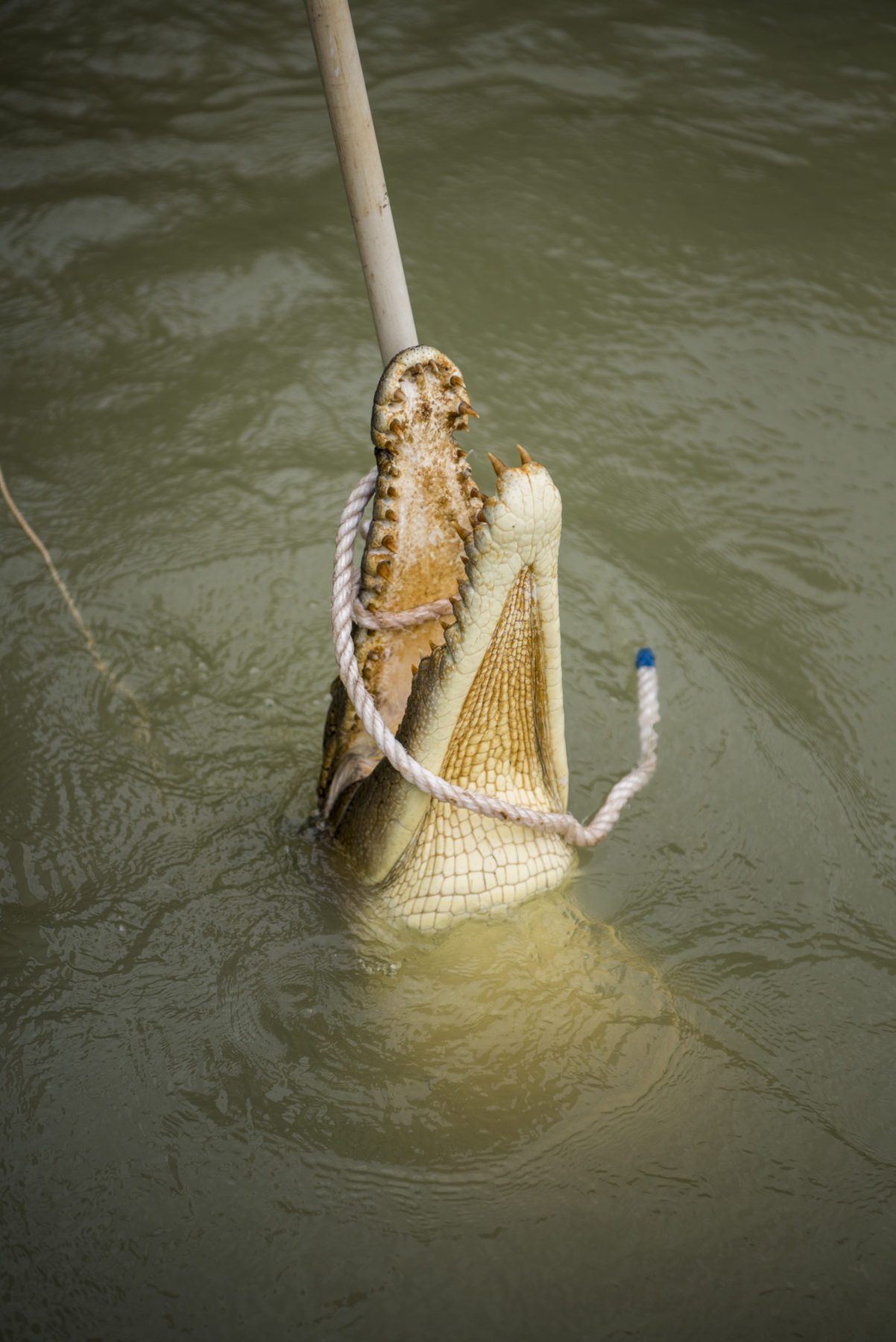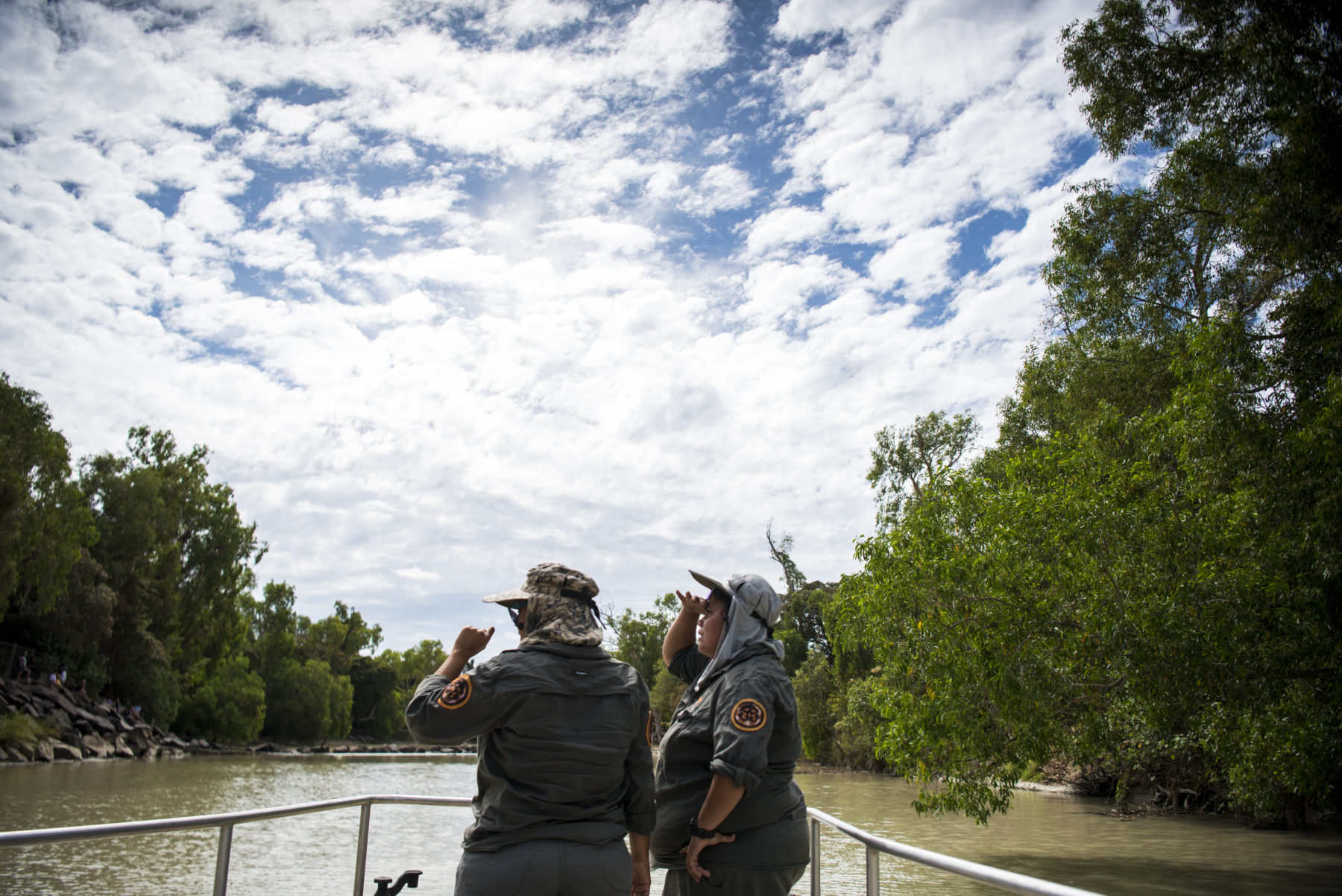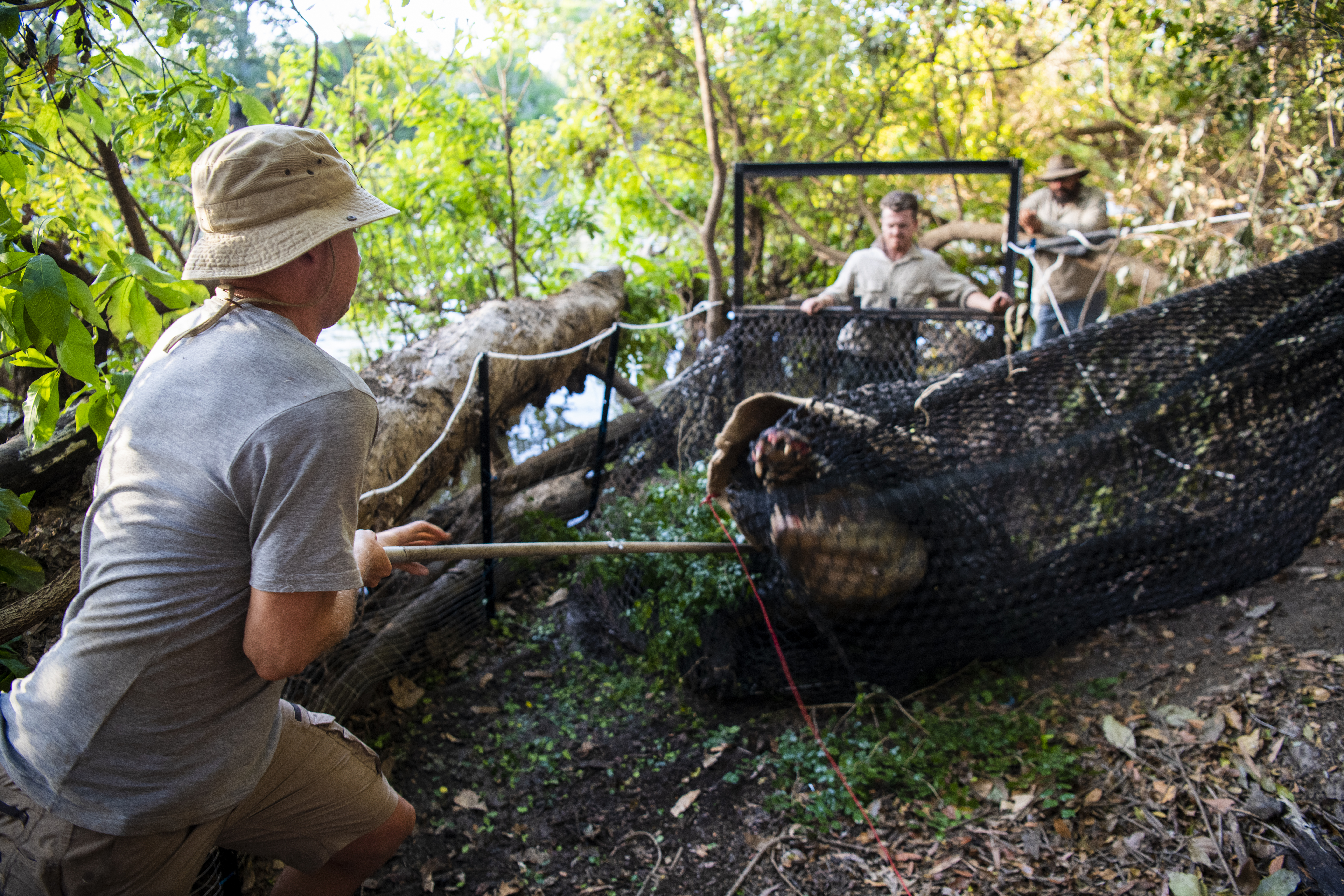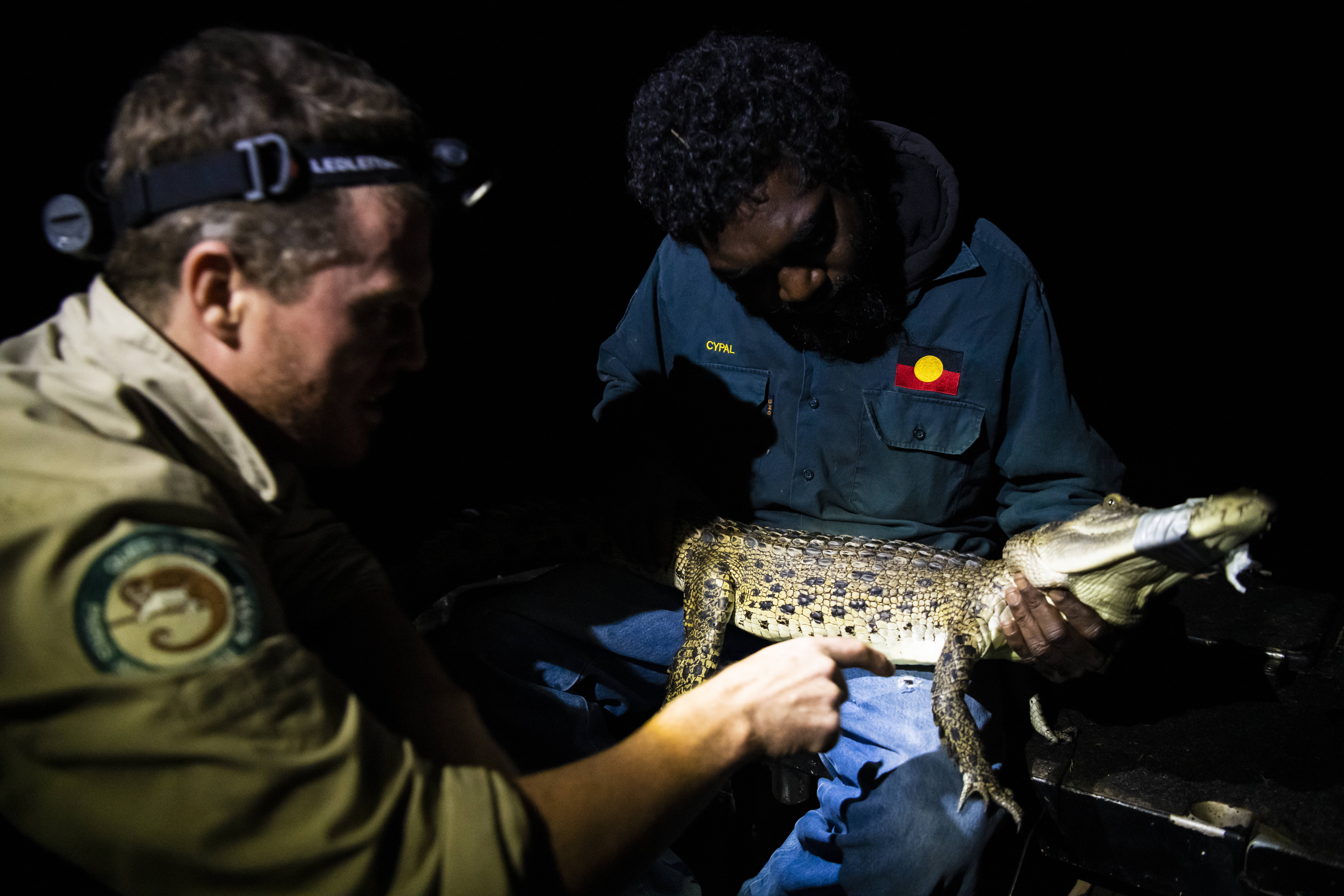How do you persuade a community to support the protection of a killer predator that silently waits in murky recreational waterways to occasionally ambush and tear apart people?
That was the dilemma facing ecologists in the Northern Territory in the late 1970s and early ’80s. After almost a decade of legal protection, the number of saltwater crocodiles around the 2m bracket was rising across northern Australia – as were attacks on people. Suddenly, after years of barely a sighting of the reptiles near Darwin, people were being killed or hideously injured in the jaws of crocs near the northern capital, and a 5.1m male, known ironically as Sweetheart, hit the headlines for terrorising tourists at a popular fishing hole, knocking them out of boats.
Politicians, community leaders and tourism operators screamed for a return to mass culling to make the newly self-governing NT safe from the huge carnivores, while the now-legendary croc researcher Professor Grahame Webb and other experts looked for creative ways to ensure the species continued to be protected. “The croc population was going up, the animals were getting bigger, and we were facing this impending collision course between humans and reptiles,” he recalls. “People were saying, ‘Those things eat cows, horses and people! Why do you want to protect them?’”
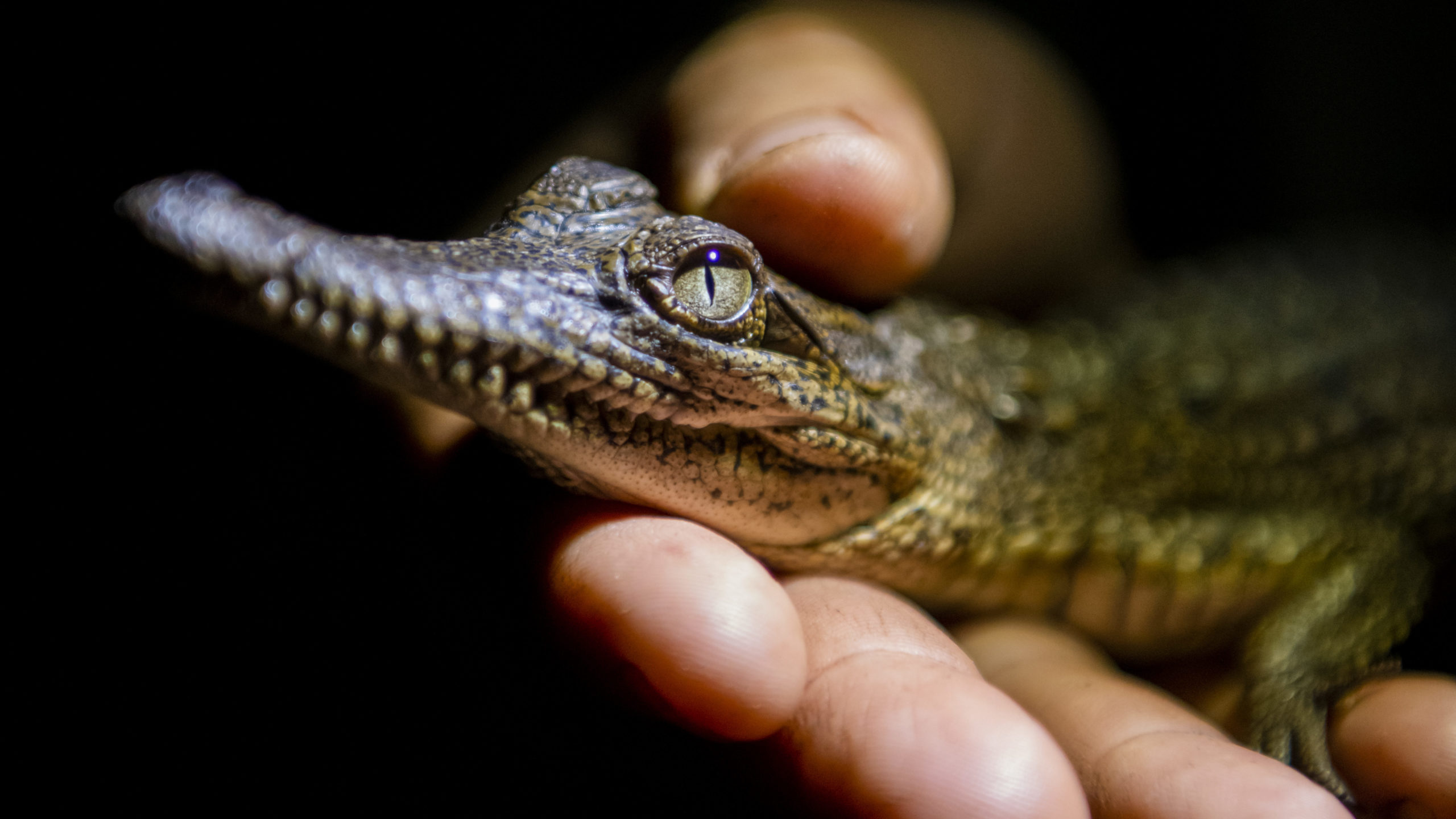
‘Salties’ might be as Aussie as koalas, but it was clear to Grahame that Territorians would need a strong incentive to develop empathy for the big reptiles. And so he and his colleagues swung their weight behind crocodile farming and tourism to transition croc protection into an economically valuable proposition. It was the beginning of what’s now known as “incentive-driven conservation”, which has helped transform wild crocodiles into a commodity, underpinning goods and services worth well over $100 million dollars to the Territory’s economy.
The NT government’s “Problem Crocodile” control program deals swiftly with potentially dangerous animals in public areas, and as many as 300 individuals are now caught annually at places such as Darwin Harbour, Litchfield National Park, and Nitmiluk (Katherine) Gorge; they are either relocated or euthanised. These days, NT croc conservation translates into many hundreds of jobs in tourism, farming and management, and the resurrection of Australia’s saltwater crocodile population is recognised as one of the world’s most stunning conservation success stories.
It’s hard to imagine in these enlightened days of wildlife appreciation that for much of the 20th century saltwater crocs were on par with cockroaches for many Australians – vermin that needed to be eradicated. They were hunted for sport and as a community service and when, after World War II, their skins became highly sought after overseas, it became open season here on the species.
A wild and reckless rifle-wielding mob of croc hunters blasted their way across the estuaries and swamplands of the country’s north, making a living under difficult and dangerous conditions. They were a notoriously tough and pioneering group of mostly men, some of whom became the stuff of legend, like Fred Pocock and Ray Petherick, each of whom in the 1950s famously brought down a few 18-footers (5.4m).
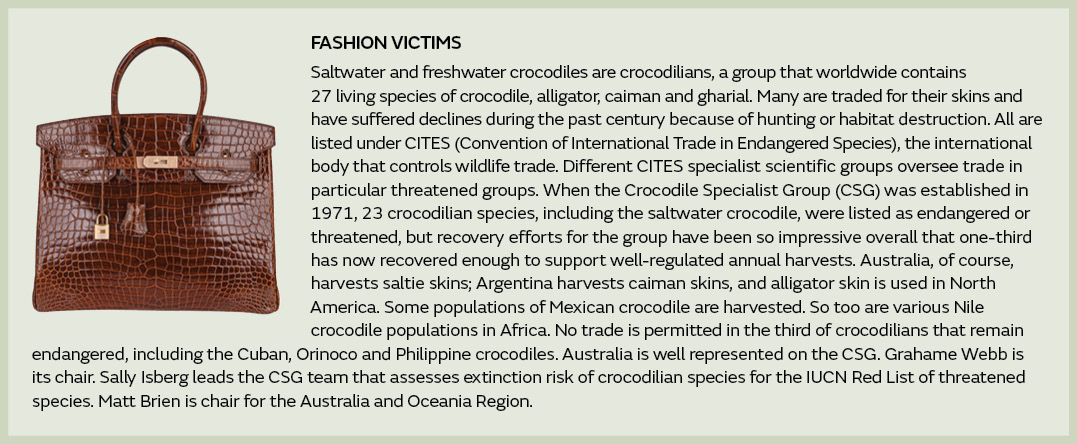
By the 1960s, the saltwater crocodile was almost extinct in the wild here, and a generation of Aussies grew up swimming freely in the estuaries and tidal river systems of the country’s north, including Darwin Harbour. Most had never even heard of saltwater crocs in Australia, let alone seen one in the wild.
Western Australia was first to introduce protection for the species in 1970, with the NT following in 1971, and finally Queensland in 1974. It was a simple action that saved the species in Australia, but ultimately led to the contentious human/reptile conflicts that peaked in Darwin during the 1980s. Before protection, saltie numbers dwindled to just a few thousand across the species’ entire range in this country, from WA to Queensland. These days there are at least a few thousand in WA alone and perhaps 30,000 in Queensland. But the species’ Australian stronghold is the NT, where at least 100,000 juvenile and adult salties are now thought to survive in the wild.
There’s no doubt you’re in croc country from the moment you step off the plane in Darwin. Airport advertising features huge crocs leaping or basking on riverbanks with mouths agape exposing massive teeth: it’s clear the magnificent reptiles have become a huge tourism drawcard for the NT. Local authorities exercise due diligence with explicit warnings near potential croc habitat, but tourists are also urged to take tours to see the reptiles safely in the wild or interact with them in captivity at one of the two major croc-themed wildlife parks in Darwin – Crocosaurus Cove and Crocodylus Park. Talk to handlers at these parks and it’s clear salties are far from the animal thugs devoid of personality they were once widely portrayed to be. At Crocosaurus Cove, for example, the reptiles are treated much like pet dogs: handlers give them names and verbal commands to which they respond, and activities to stimulate their brains.
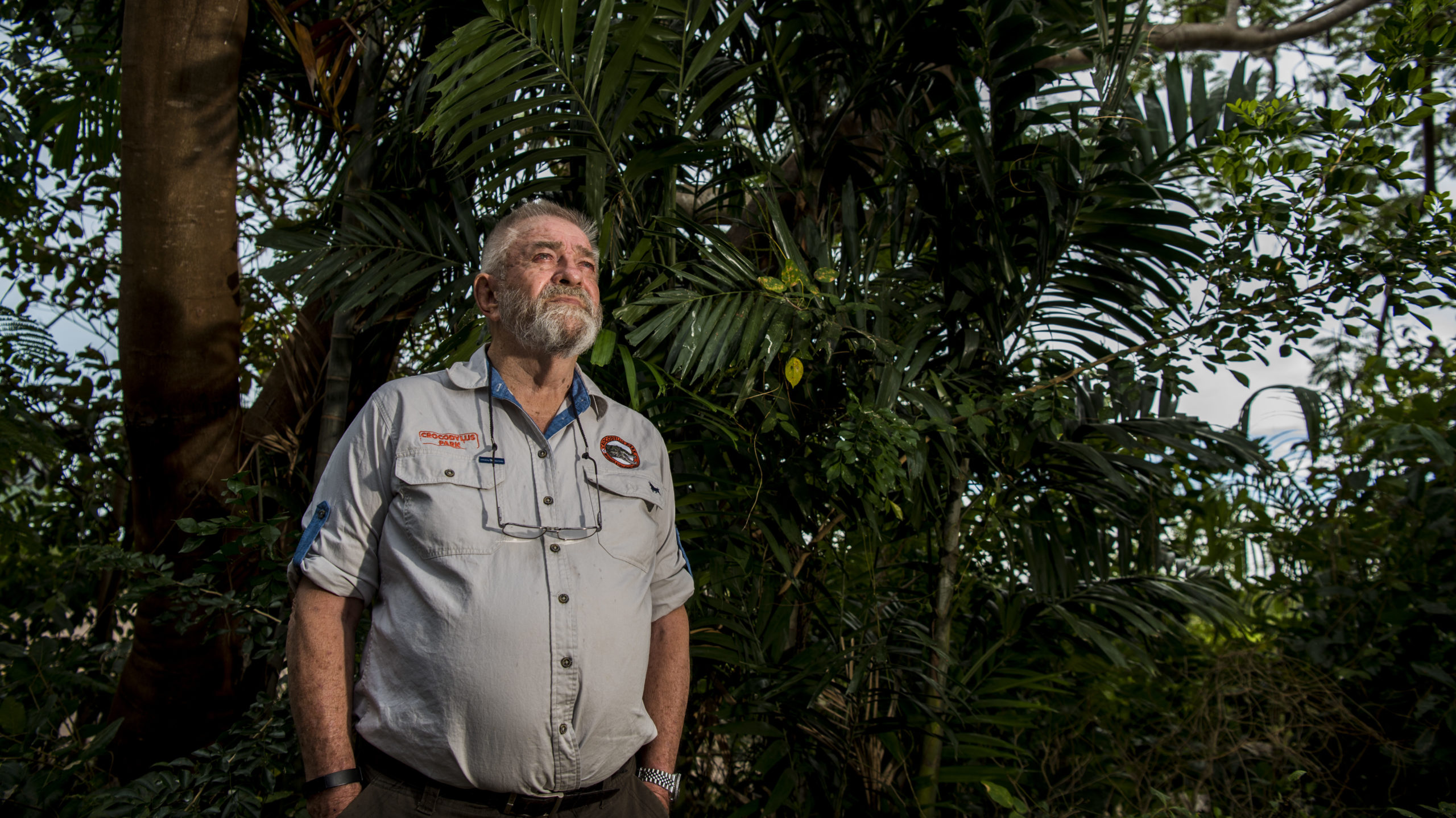
Dr Sally Isberg, who completed a PhD in crocodile genetics at Sydney University’s Agriculture Department, is now a patriotic Territorian. She’s passionate about all crocodilians, but, like Grahame, is pragmatic about the need for an imaginative response to make the wider community care for a carnivore as dangerous as the saltwater crocodile. She established and runs the Darwin-based Centre for Crocodile Research, which oversees research and development to improve efficiency and productivity in the croc-farming industry. She consults to Crocosaurus Cove and the wider croc-farming industry about animal husbandry, notably the health and ethical treatment of captive animals.
Sally points out that farming crocodiles is much like farming cows, sheep or chickens, and is overseen by similar rules and regulations in Australia that apply to other livestock. She has a major role in ensuring sustainable management is pursued using humane and hygienic practices, and she says that’s the way the majority of the industry now operates. She concedes, however, that historically that may not have always been the case.
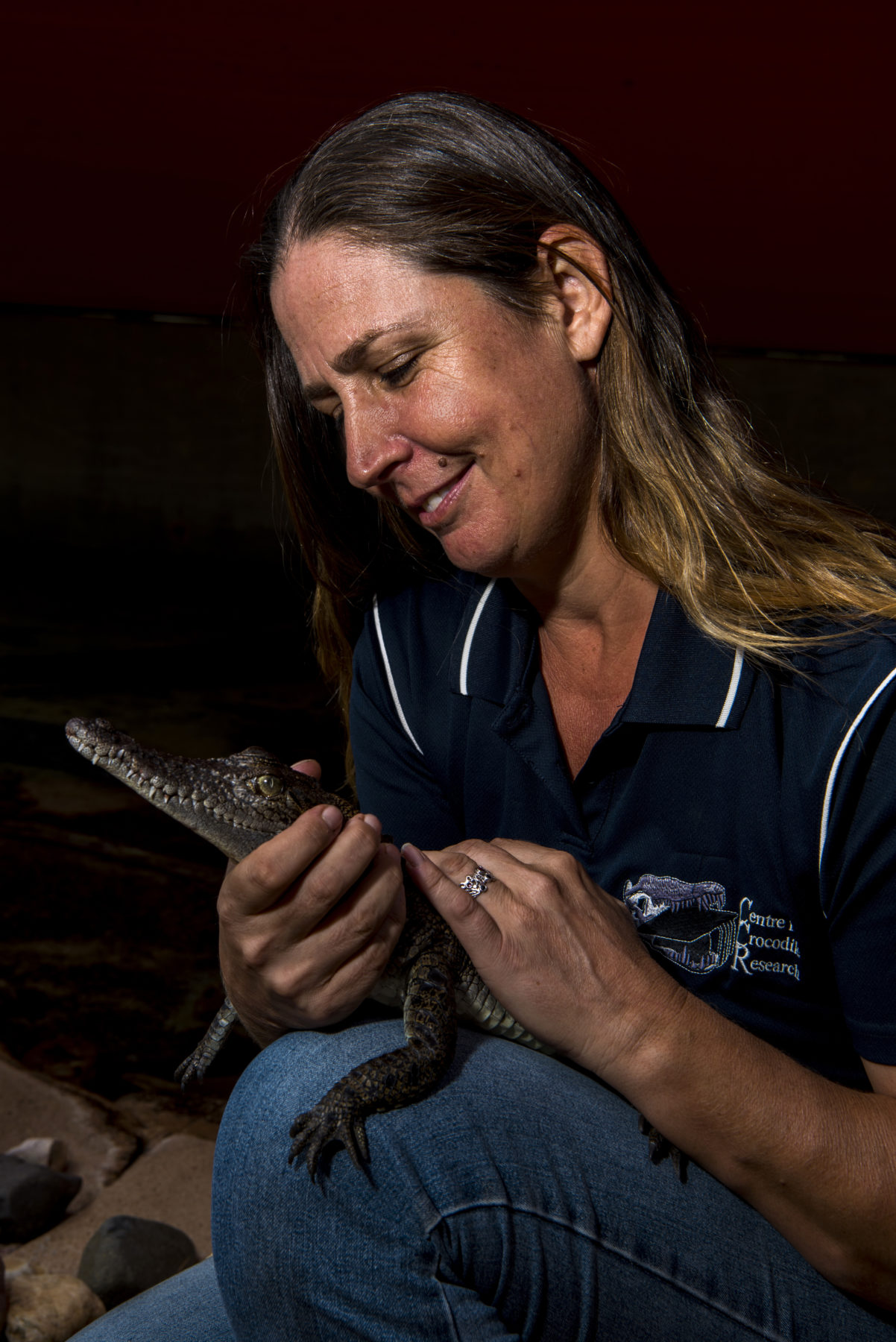
Australia’s first farms were started in the late 1970s by local operatives. Now most NT croc-farming operations are either fully or partly owned and funded by high-end French fashion houses, notably Louis Vuitton and Hermès. Animal welfare aside, Sally says, it’s not in these brands’ interests to support animals kept in overcrowded and unhealthy conditions. Apart from the public-image problems it might generate, it doesn’t equate with the quality leather needed for designer crocodile handbags that can each fetch $US50,000 or more.
Most animals in the industry are harvested at about three years, or a length of about 1.6m, which provides enough belly skin at the size and scale preferred by the fashion market in crocodile handbags. The animals enter the farms as eggs, which are largely sourced from the wild. “Most eggs die in the wild due to flooding and predation, so this is seen as capitalising on a potential loss,” Sally explains. Permits are issued for up to 90,000 viable saltwater croc eggs to be harvested each year in the NT. Any NT landholder who preserves saltwater crocodile habitat on their property and tolerates the animals nesting can also receive a financial windfall by selling eggs. However, most nesting in the NT is on Aboriginal land, and eggs are collected by or under the supervision of Traditional Owners (TOs), so it’s largely Indigenous people who operate in, and benefit from, this stage of the supply chain. “Every crocodile nest needs to have a risk assessment before harvesters go in and open it up,” Sally says, explaining harvesting is a dangerous job because nests are usually well guarded by adult females. “And they need to be very careful in opening up a nest to make sure eggs don’t rotate.” Crocodile eggs aren’t leathery like those of most reptiles. They’re like very hard birds’ eggs, but unlike birds’ eggs, don’t tolerate being rotated during incubation. This is because developing embryos attach to the upper margin of eggs, meaning they need to stay in an upright position to survive through to hatching. To ensure that happens, each egg is marked with a line as a nest is opened, enabling eggs to be removed, transported and later incubated in the same orientation in which they were found.
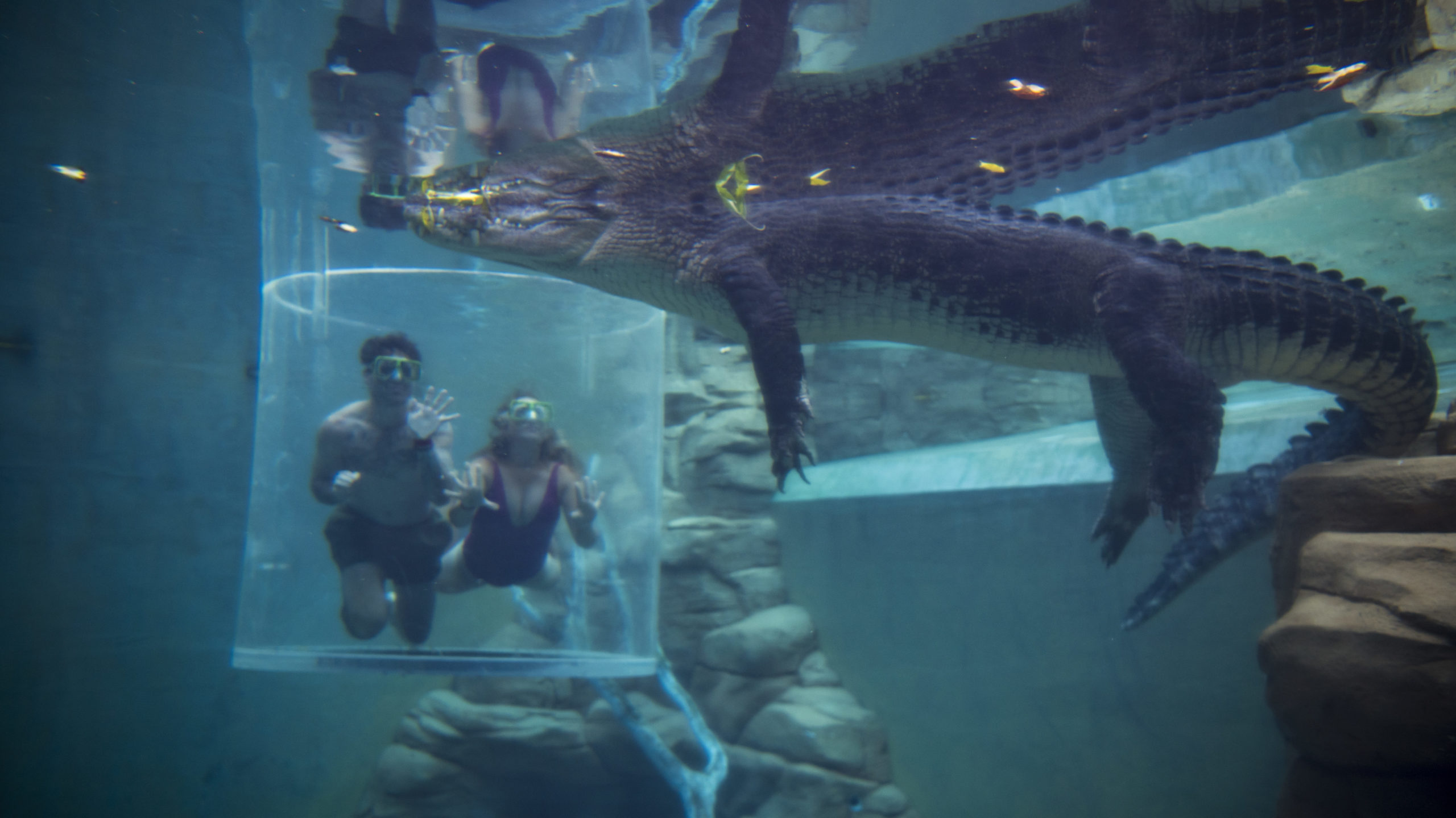
The Yolŋu people in East Arnhem Land have for many years been harvesting saltwater crocodile eggs in the Arafura Swamp – a huge, pristine inland floodplain – to sell to Darwin farms. But in 2021 the Arafura Swamp Rangers Aboriginal Corporation began taking the operation up a notch with the completion of the first stage of a state-of-the art facility in the community of Ramingining to hatch the eggs and grow hatchlings to about 1m in length, before selling them to the various farms. The project, which taps deeply into long-held Indigenous knowledge of saltwater crocodiles, has been widely lauded for creating employment and income in one of Australia’s most remote communities. The second and final construction stage of the project, which is being funded jointly by both the NT and federal governments, was due for completion in late 2022.
The perceived monetary value of saltie eggs makes them a target for some of Australia’s most sophisticated theft operations. In Kakadu National Park, which has become a saltwater crocodile safe haven since protection for the species was introduced, there’s no commercial egg harvesting because it’s a World Heritage area under federal government management. And yet that hasn’t stopped thieves arriving in helicopters to raid saltwater croc nests. In one past illegal sortie onto the park, about 30 nests were raided. “If we catch them,” says Garry Lindner, supervisor of Crocodile Management and Coastal Surveillance in the park, “they’ll lose their helicopter. We’ll go all out to seize it and seek confiscation through the courts.”
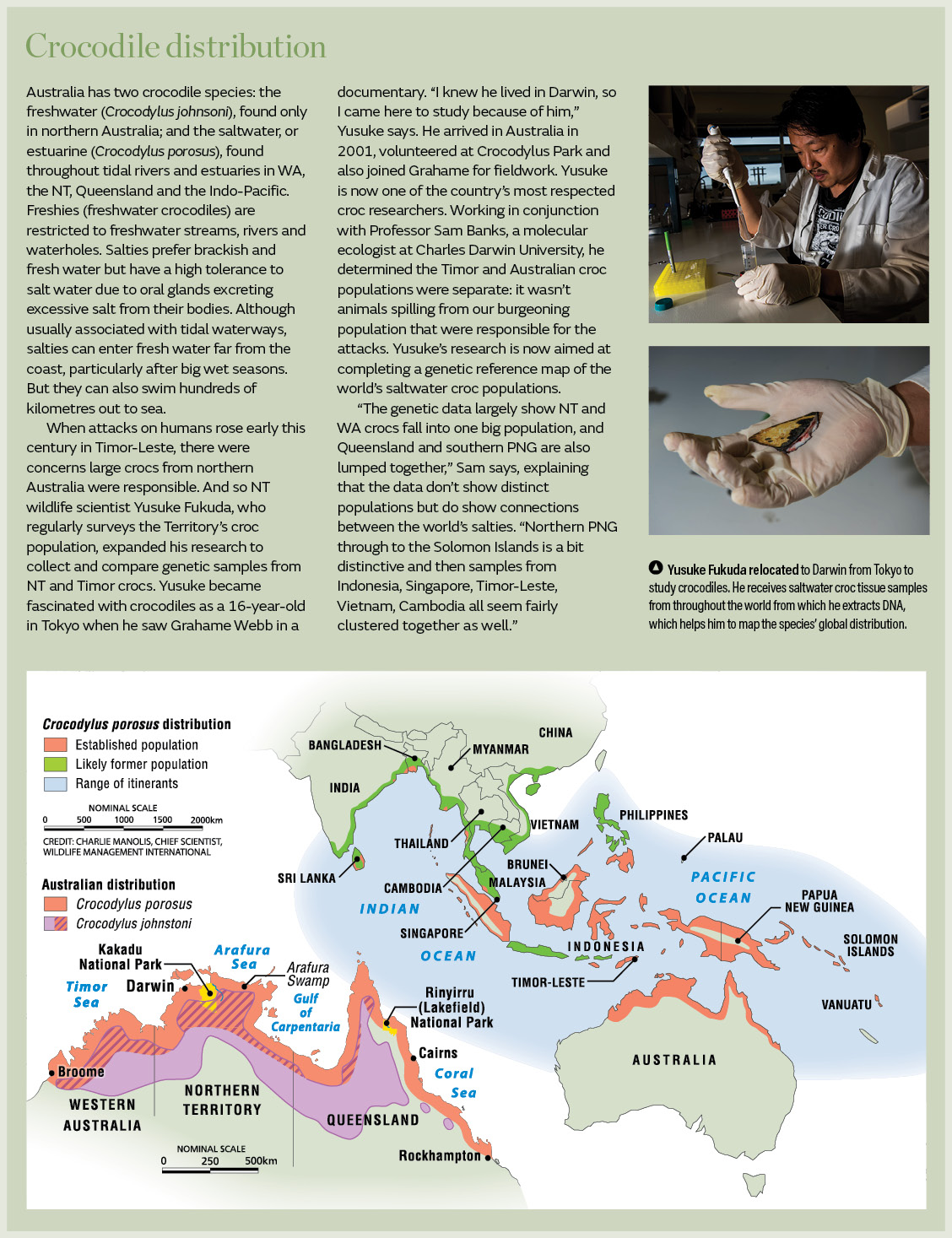
Garry, who’s been working in wildlife management in the park for almost three decades, says saltwater croc numbers in Kakadu have reached the level they would have been before Europeans arrived. Up to 10,000 juvenile and adult saltwater crocs now live and breed in the 20,000sq.km park, and that’s probably maximum carrying capacity for the species there. It’s a population controlled by Kakadu’s mostly natural rhythms and is not expected to grow in density or total number. But the upper average size range of crocodiles in the park, where the biggest animals are mostly 2.5–4m, is likely to continue increasing. Perhaps, after another decade or two of protection, we might see individuals in Kakadu reaching the species’ upper potential size range, which is thought to be 6m-plus.
For salties to reach that size takes a lot of luck, particularly in their early years. Egg mortality in nests is high, with an average 75 per cent failing to hatch in the wild, and then life as a croc hatchling is notoriously precarious. Hatchlings are guarded by highly protective mothers for their first 2–3 months. Then the next few years are spent avoiding the mouths of pythons, barramundi, catfish, black-necked storks (jabirus), birds of prey, feral cats, and larger saltwater crocs. If they make it to about 2m – about 13 or 14 years – their only threats are humans and larger crocs, although animals that swim in coastal estuaries or out to sea are sometimes attacked by sharks. It’s estimated that less than one in every 50 eggs – the average number laid in a nest – will make it to the 2m stage.
Garry Lindner’s team deals with interactions between humans and crocs in the park and tracks and collects data on the croc population there. We join him and two of his young rangers – Desiree ‘Des’ Neidjie and Charlotte Bayne – on a late spring afternoon for a training exercise on East Alligator River. We climb into a purpose-built croc boat – open but protected by high railings and with a flat bottom so it can glide across shallow water. It’s heavily built to withstand knocks from crocs and also barramundi, which can reach more than a metre in length. We head out looking for an undocumented croc of no more than 2.5m so Des and Charlotte can do a catch, tag and release procedure.
Charlotte’s mother grew up in the central Kakadu area, around Yellow Waters. Des, a Gaagudju and Bunitj woman, is from the land at the park’s northern end. Her grandfather Bill Neidjie, a Kakadu Elder famed for his commitment to protecting the natural environment here, was instrumental in seeing Kakadu achieve national park, and then World Heritage, status.
East Alligator is one of four major tidal rivers connecting Kakadu with the ocean to the north and on any given day its banks are lined with basking crocs. At night, when they prefer to hunt, the river lights up with croc eyeshine. We head upstream past Cahills Crossing, where in September–October up to 40 large saltwater crocodiles at a time line up to gorge on mullet and barramundi arriving to breed in the river from the ocean on spring tides. Garry says this annual end-of-dry season phenomenon has become one of the world’s great wildlife viewing opportunities since crocodiles returned to Kakadu. Raised platforms built there have recently been upgraded to safely accommodate the ever-growing numbers of tourists it attracts.
Just past the crossing, a huge 4m animal lying on the riverbank is opening and shutting its mouth. It’s undoubtedly a male because females rarely grow longer than 3.5m. Garry explains it’s probably trying to bring up a furball. Crocs can’t digest keratin and so hair and nails from mammals, such as feral pigs, on which larger crocs prey, concentrate in their stomachs into sometimes soccer ball–sized accumulations that are then regurgitated. “That’s special to see,” Garry says. “Seeing behaviour like that is why I love Kakadu – these crocs are just doing their stuff and we get the privilege of watching. It’s only been in the last 20 years we are starting to see the real Kakadu and learning so much about the behaviour of the species that hasn’t been documented before.”
We motor past Catfish Creek, where in 1985 Sydney academic Dr Val Plumwood, en route to an Aboriginal art site, was knocked from a canoe by a large crocodile and severely mauled. She fought back, escaped to higher ground and was later found near death but alive, surviving to became an advocate for crocodile conservation.
We locate an appropriate croc specimen for the women to test their data-gathering techniques and Garry snares it with a small harpoon. As Des manoeuvres the boat, Charlotte brings the croc to the boat’s edge, where, using first a cable tie and then duct tape, Garry secures its jaws safely shut. The croc is then brought on board by Charlotte where its length (2.5m) is measured, along with a range of other metrics; it’s sexed (male); and marked permanently and uniquely (349) by the removal of tail scutes – bony external plates – according to a particular pattern. It’s an ID system used widely by crocodilian researchers worldwide and means a crocodile can be identified throughout its life. Finally, the animal is given a name (Fynn) and returned to the water. We later take the scutes back to Darwin for DNA to be extracted and entered into a global database (see page 75).
“This is a special place where crocs can do their thing, without interference,” Garry says. “That’s the beauty of Kakadu from a conservation point of view. Because it’s a Commonwealth reserve, wildlife can just do what it does, and you also get local Indigenous people hunting in tune with what they did historically.”
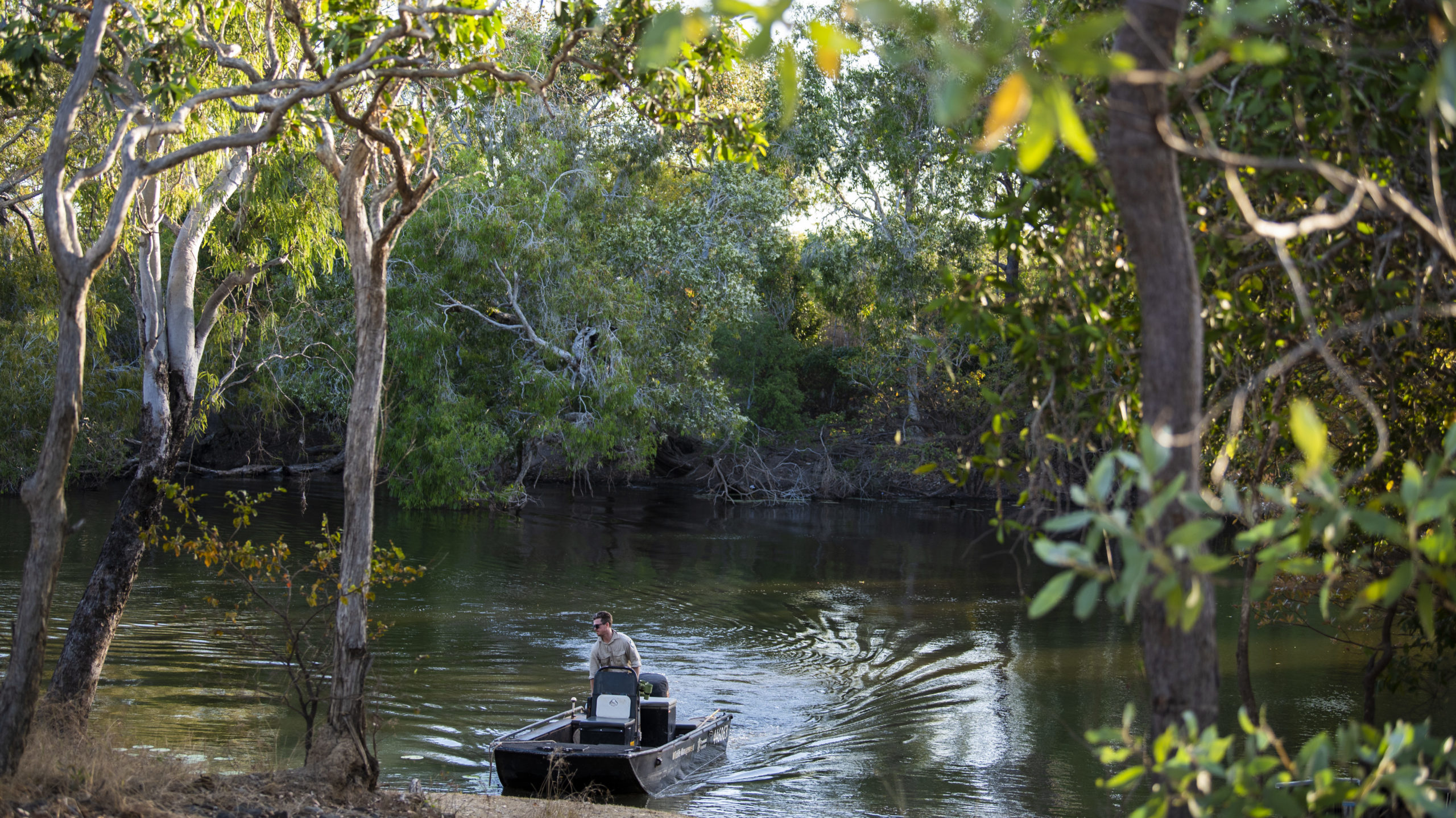
Although Kakadu struggles with several ongoing maintenance problems – from water weeds choking its waterways to feral buffalo and pigs trashing habitat – it’s finally got its top-order predator back wielding influence over its plants and animals. “What we’re seeing now is something that hasn’t been seen in more than 200 years, since the time of first European contact with Indigenous people – it’s unique. A lot of people grew up here not knowing what a peak croc population was like and now we are actually seeing that.”
Dr Matt Brien and his team are working quickly to safely secure a 5.2m croc caught in a gate trap set deep into riverbank vegetation at Seven Mile Waterhole on the North Kennedy River, in Rinyirru (Lakefield) National Park in Queensland’s eastern Cape York Peninsula. “What a dinosaur,” Matt whispers in hushed reverence. He is program coordinator for the Queensland Parks and Wildlife Service (QPWS) Northern Wildlife Operations; croc management takes up most of the team’s work, ahead of cassowaries and flying foxes. He’s been in croc research and management for more than 20 years and spent time early on working with Grahame Webb.
The huge crocodile captured at Seven Mile has had its tail scutes cut, indicating it’s been caught previously, and Matt’s confident he recognises him. When Matt later checks the records, it turns out he attached a radio transmitter to this animal in 2003 as part of a tracking study and gave him the name Chopper. In the two decades since then, Chopper has grown about 50cm in length.
When a saltwater crocodile reaches this size, there’s also been an exponential growth in its body mass so, it’s not only very long but also very wide and bulky. Chopper’s head alone is now about 60cm wide, and he looks to measure more than a metre across his body at its widest. (You don’t take a measuring tape to a carnivore of this size, so measurements have to be estimates.)
Chopper now seems to be 700kg or more in weight: he’s truly huge and, understandably, not happy at being caught, which is evident by the low-pitched rumble he’s emitting. But he’s surprisingly still, almost as if he realises there’s no point expending energy if there’s no clear escape plan.
With crocodile numbers growing in Queensland as they have been in the NT and WA, QPWS has been expanding its work in the research and management of potential conflicts between the reptiles and the general public.
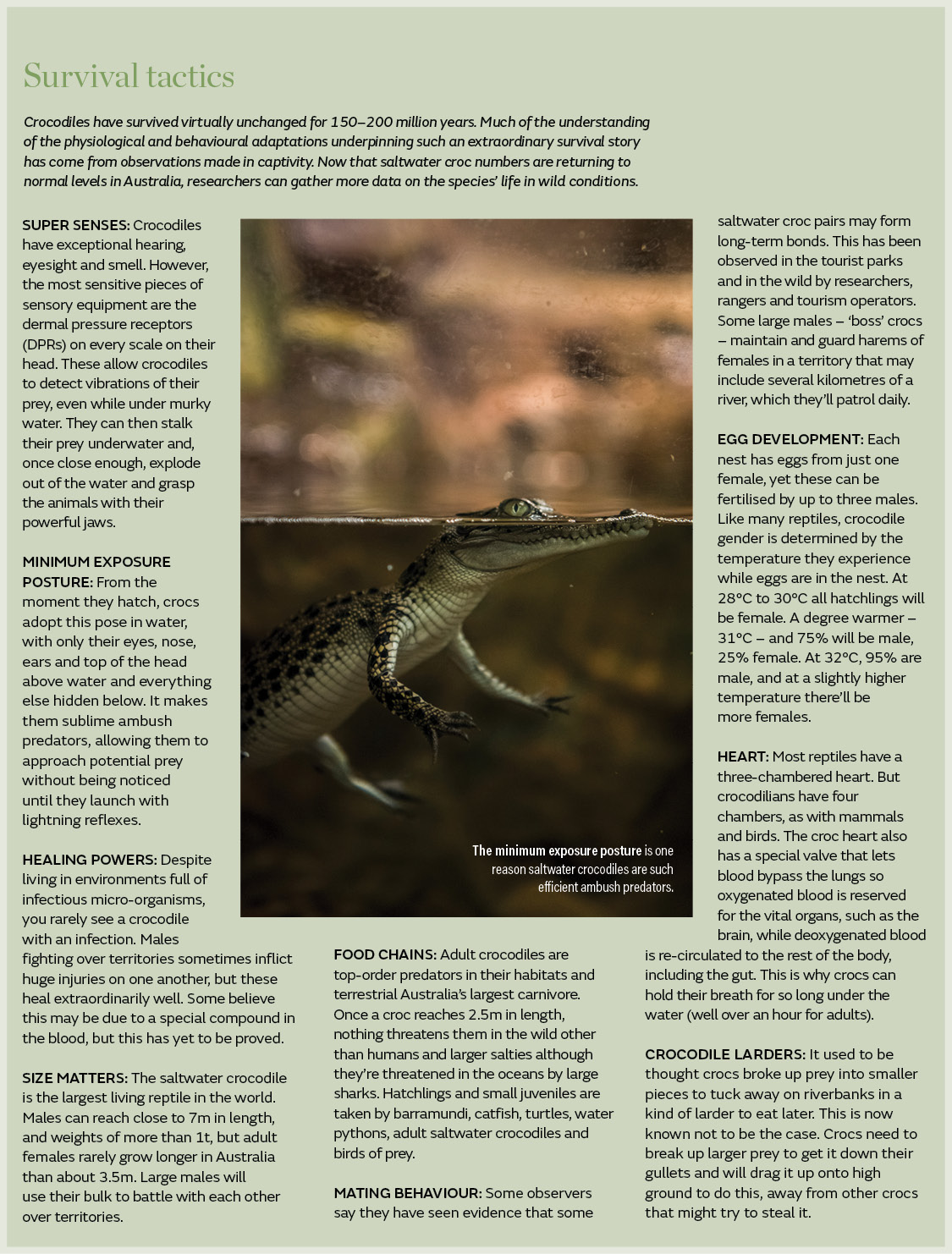
Since 1975 Queensland has had 46 crocodile attacks, including 17 that were fatal. Attacks are rising, mostly along the east coast where the human population has grown along with the croc population, which has been climbing back to its original size after protection. Matt’s team now remove about 50 animals a year in response to public concern, many of them in the Cairns area.
“With a large predator that’s increasing in number you have to manage them around people,” Matt says. “The bottom line is, with the success of crocodile conservation, you want almost no crocodiles where there are lots of people and lots of crocodiles where there’s no people. So, in and around Cairns [far north Queensland’s most populous city], you just can’t have big crocodiles.”
Senior field ecologist Dr Laurence Taplin, who’s worked on surveys of the Queensland population since the mid-1980s and now consults to Matt’s team, explains that genetic studies show there are essentially five or six separate populations of the reptile across the state, with little interaction between them. Removing large animals doesn’t mean others will move in from another area to take its place, as was once thought. “The fatal attacks are big animals,” Laurence says. “The non-fatals are caused by animals typically between 2m and 3m; so they’re big enough to see splashing in the water, become interested and approach, but when they grab hold, it often tends to be they’ve bitten off more than they can deal with because humans can fight back and crocs tend to let go when that happens.”
During his latest capture, Chopper is being fitted with a sonar tag as part of a trial using multibeam sonar and artificial intelligence technology to detect crocodiles under water, alert QPWS officers about their presence via phone networks if they enter an area where people swim, and then deter them with unpleasant sounds. At this stage it’s still a pilot project, but early results are promising.
“People can’t swim at the beaches and estuarine areas in northern Queensland [because of stingers and sharks], but we’ve got all these beautiful rivers and creeks up in the mountains like Crystal Cascades – the problem is crocodiles are now moving into these areas, and so we are trying to find a way to better detect and deter animals moving into these upper freshwater areas,” says Matt. It’s one of several detection strategies being developed by QPWS to manage potential croc–human conflicts. Another is eDNA technology (see And now for CSI Australia, AG 169), whereby simple water testing can reveal if a creek or river has crocodiles present.
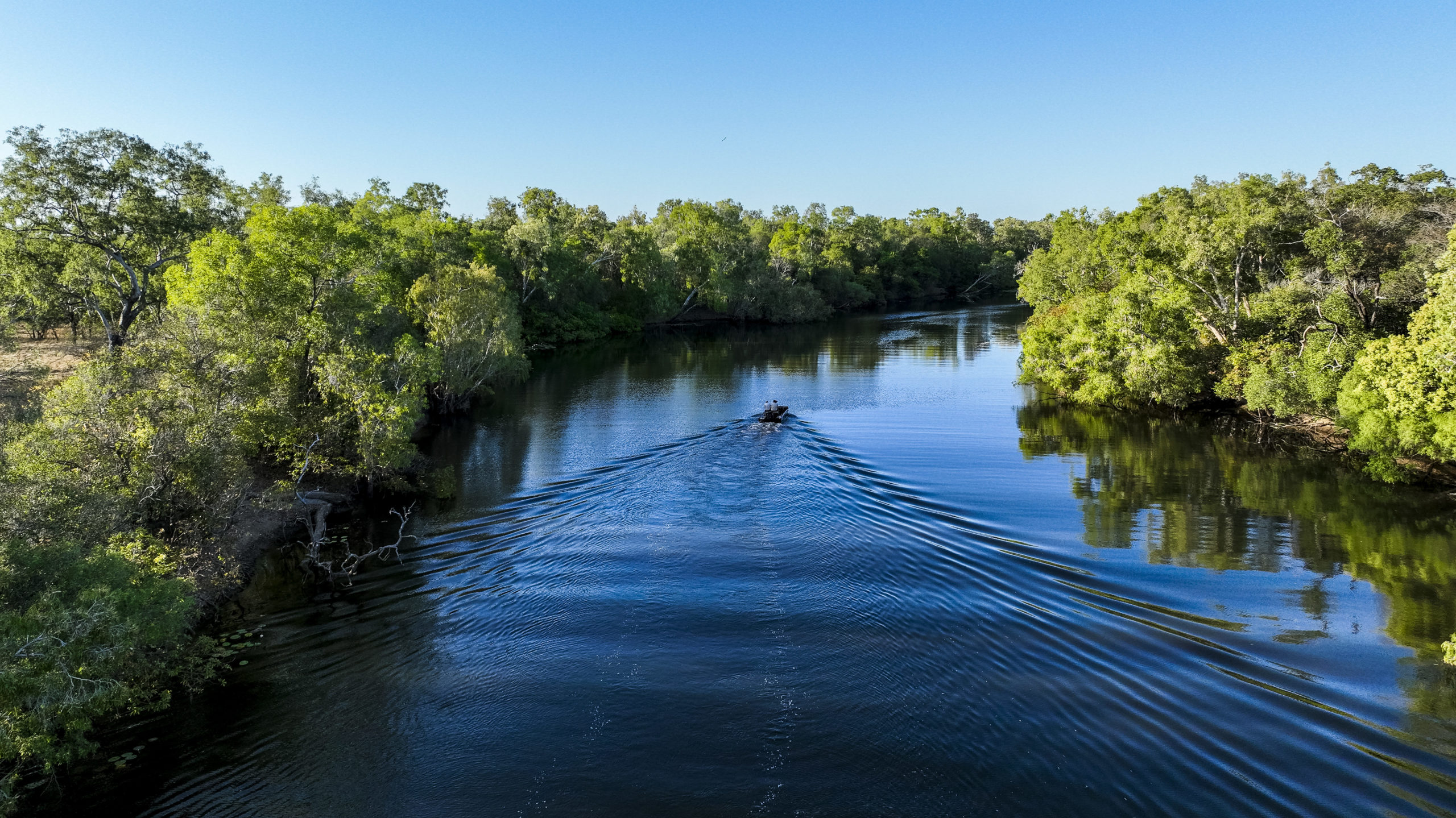
QPWS is also experimenting with crocodile capture and trapping techniques, adapting the best of what’s been developed around the world but also developing its own approaches, including the use of drones to catch crocodiles by dropping snares over their snouts. The range of capture techniques is necessary for different crocs in different environments. Matt says this means he and his team can move in quickly when problem animals have been identified, catching and removing most within 48 hours.
Laurence and Matt are surprised there aren’t more attacks in Queensland because they see so many people ignoring crocodile warning signs. Crocodiles are naturally wary of humans and tend to keep their distance anyway, so following simple protocols to avoid crocs works well. Statistics show it’s mostly local males who are likely to be blasé about warnings that get attacked; alcohol is often involved.
Laurence and Matt speculate that Chopper must be 60 to 70 years old and evading humans would have been how he’s made it to such an age. He’s somehow avoided getting his head blown off during the era when hunters would have taken out most of his compatriots.
He’s been lying quite still while his restraints are in place, but as soon as they’re loosened, he seizes his chance to escape. One massive thrust of his tail and he silently and swiftly slips back into the water. Just upstream a couple fishing for barramundi from a tinnie are oblivious as he passes silently beneath them and swims to freedom.
The sonar system detects Chopper cruising these waters – his territory – daily, during the next few weeks. But no-one sees him, and if it stays that way he’ll likely live for another decade or two.

